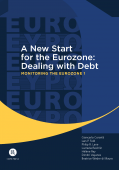Yesterday I attended the launch of a new CEPR (free) e-book, A New Start for the Eurozone: Dealing with Debt. Written by some of Europe’s most distinguished macroeconomists, it notes that a return to sustainability requires a reduction in the legacy debt burden. It proposes using the seigniorage revenues from the Euro to finance a one-time debt buyback for the most indebted Eurozone countries, reducing their debt-GDP ratios to a sustainable level. This would be combined with a stronger regulatory structure to prevent future debt build-ups (and mitigate the unavoidable moral hazard involved in the first step), and the creation of a safe asset, a synthetic European bond.
 This is very far from my area of expertise, so it sounds a promising package of measures but I’m not in a good position to evaluate its details. Among the audience at the launch, the questions centred almost entirely on political economy questions: how could European governments be persuaded to do anything now the markets are calm? how would the new measures sit within the existing institutional framework? could northern Europe (Germany) be persuaded to allow the seigniorage revenues to be used in this way?
This is very far from my area of expertise, so it sounds a promising package of measures but I’m not in a good position to evaluate its details. Among the audience at the launch, the questions centred almost entirely on political economy questions: how could European governments be persuaded to do anything now the markets are calm? how would the new measures sit within the existing institutional framework? could northern Europe (Germany) be persuaded to allow the seigniorage revenues to be used in this way?
In short, an economic no-brainer – that the debt legacy has to be tackled – is a political no-no. The fact that the economic hurdles are huge but the barriers to reform are political was brought home by Gillian Tett’s Financial Times column this morning. She writes: “On the eastern side of the Atlantic, policy makers are now at pains to suggest that a Greek default, or even a eurozone exit, would not be disastrous; at last week’s International Monetary Fund meetings German officials argued that the chance of a Greek exit had already been priced into the markets, and that shocks could be contained.”
She argues – and I agree – that the Eurozone could yet go very pear shaped, and the dangers of renewed systemic financial crisis are non-zero. At least if the pessimistic view is correct, the political economy of reform along the CEPR or other lines will become more favourable.

I suspect if one was to draw a Venn diagram with one set containing economic policies that would work, and another with policies that are politically likely to be used, the intersection of the sets would be reasonably small.
Pingback: Debt, no brainers and no-nos | Homines Economici
The problem with the Euro boils down to this – you cannot have a monetary union without a fiscal union and there can be no fiscal union without a common electorate.
A helicopter debt buy back may be possible in a sovereign country in control of it’s own currency but even there addressing the moral hazard and politics of “printing money” would be challenging to say the least.
Interesting, I explained all this quite clearly yesterday, Thursday, in “Budget Planning”.
It does not require a respected economists to explain the obvious. We should move a way from the cult of the expert especially in the field of economics, and head towards something far more intelligent, and open. See the following http://www.p2pfoundation.net/Universal_Debating_Project
It does not require a respected economist to explain the obvious. We should move a way from the cult of the expert especially in the field of economics, and head towards something far more intelligent, and open. See the following http://www.p2pfoundation.net/Universal_Debating_Project
Pingback: Book Bits | 2 May 2015 | The Capital Spectator